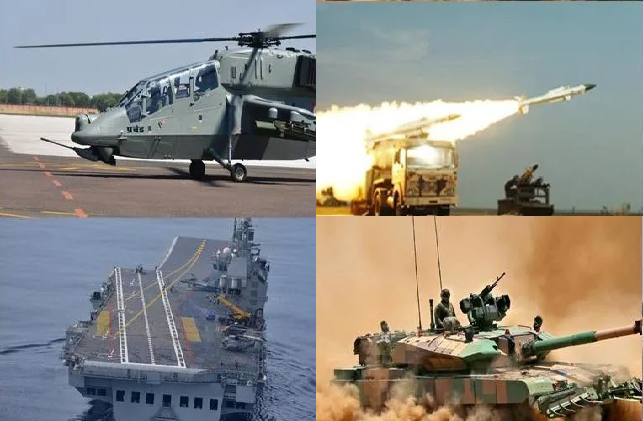
- The Ministry of Defence (MoD) signed contracts with HAL for 156 LCH ‘Prachand’ to the Indian Army and the IAF, enhancing their capabilities for operational control in high mountain combat areas.
- The Artillery Modernization Program, worth ₹6900 crore, was launched on March 26, 2025, to provide the Indian Army with 155mm/52 Caliber Advanced Towed Artillery Guns, as well as 6×6 Gun Towing Vehicles in the future.
- The Defence Acquisition Council (DAC), in its meeting held on 20 March 2025, cleared capital acquisition proposals worth more than ₹54,000 crore.
- March 2025 defence spending of more than 1.3 lakh crore is a major initiative to modernise the military and at the same time Aatmanirbharta.
Strategic foresight and defense preparation are now essential components of national sovereignty in a time of ever-changing security challenges. By investing a significant portion of its yearly defense budget of ₹6.21 lakh crore (about $75 billion) in several high-impact procurement and modernization initiatives, India has made significant progress in 2025. This is one of the most significant recent pushes for technological advancement, war readiness, and indigenization.
“Strength respects strength,” as former President and scientist Dr. A.P.J. Abdul Kalam famously said. A nation with strength in its body, mind, and weapons will bring about peace, not one that is weak. This vision is reflected in India’s recent defense expenditures, which support the goals of the Aatmanirbhar Bharat (self-reliant India) effort while adhering to the theory of “peace through strength”.
The Ministry of Defence has ensured that budgetary expenditures are converted into long-term strategic returns by implementing advanced Light Combat Helicopters (LCH Prachand), new-generation artillery systems, anti-tank platforms, and domestic radar systems. According to the wise words of Chinese strategist Sun Tzu, “He who wishes to fight must first count the cost.” India’s defense planners appear to be investing in staying power, deterrence, and a self-sustaining military economy in addition to weapons.
The major contracts signed in March 2025 are covered in this articl,e along with their consequences for national security and how India’s defense spending is influencing the course of its military.
₹62,700 Crore Contracts with HAL for Light Combat Helicopter
On March 28, 2025, the Ministry of Defence (MoD) signed two important contracts with Hindustan Aeronautics Limited (HAL) for the delivery of 156 Light Combat Helicopters (LCH) Prachand to the Indian Army and the Indian Air Force (IAF), enhancing their capabilities for operational control in high mountain combat areas. The LCH is both an offensive and defensive platform that incorporates advanced stealth capabilities, maneuverability, and high-altitude operability, making it well-suited for India’s diverse combat environment. Previously, 15 LCHs had been inducted, 10 with the IAF and five with the Indian Army, under separate contracts. The new contract for 156 helicopters is a considerable acquisition over a phased delivery timeline of 10 years.
The acquisition is a boost for India’s indigenous combat aviation capability, especially in areas like Ladakh and Arunachal Pradesh, where warfare requires a peak performance capability. The LCH incorporates a modern generation of avionics and a new generation of weapons to operate in austere operating environments to give the Armed Forces an aerial capability. The LCH integrates an advanced weapon system including air-to-air and air-to-ground missiles, 70mm rockets and a coupled gun system; the helicopter will also have the ability to carry the HELINA (Helicopter Launched Nag) anti-tank guided missile for improved precision strike against armoured targets. The LCH has a HAL/Turbomeca Shakti-1H1 engine, a twin-turboshaft engine that was developed together with Safran, a French company, to enable an effective operational capability at the high-altitude operating environment. The engine provides an effective and efficient capability to operate under adverse conditions.
The Artillery Modernization Program
The Artillery Modernization Program worth ₹6900 crore was launched on March 26, 2025, to provide the Indian Army with 155mm/52 Caliber Advanced Towed Artillery Guns, as well as 6×6 Gun Towing Vehicles in the future. This will result in improved mobility and long-range precision firepower for the army – important requirements for modern warfare. The 155mm/52 Caliber Advanced Towed Artillery Guns will provide better long-range weapon accuracy to support ground forces. These are more accurate in their targeting than systems previously fielded, can deploy more efficiently, and improve fire control. In addition, the Army will improve mobility using 6×6 Gun Towing Vehicles, therefore allowing quicker deployment over different terrains, which will also improve responsiveness on the battlefield.
An important aspect of the upgrade will be the Advanced Towed Artillery Gun System (ATAGS), which is designed and developed in India. The ATAGS can provide an agile long-range strike capability due to its range of greater than 40 kilometers. The future development of its self-propelled version will enhance the battlefield adaptability further. The ATAGS greatly bolsters India’s defense posture, especially along its mountainous borders with China and Pakistan. The modernization demonstrates a commitment to improving national defense through precision, mobility, and long-range artillery capabilities; enhancing national security, increasing lethality on the battlefield, and acting as a significant deterrent in potentially high-stakes geopolitical situations.
Aatmanirbhar Bharat Push: ₹2,500 Crore for Anti-Tank Platforms & Light Vehicles
Strengthening its logistical and mechanized forces has long been a priority for the Indian Army. Light vehicles and anti-tank platforms were formerly employed sparingly, primarily through imports or joint ventures. Under the Aatmanirbhar Bharat initiative, the recent approval of contracts worth ₹2,500 crore for the NAMIS Tracked Anti-Tank Weapon Platform and 5,000 light vehicles is a major step towards military manufacture becoming self-sufficient. The NAMIS Tracked Anti-Tank Weapon Platform is built to move quickly over a variety of terrain, including mountains and deserts. It can precisely target opponent armored combat vehicles because of its sophisticated fire-control systems and guided missile capabilities.
To strengthen India’s defense capabilities, the stations will be positioned in key critical sites. The 5,000 newly purchased light vehicles will also significantly improve logistics, reconnaissance, and military movement. The vehicles’ improved mobility, improved armor protection, and all-terrain adaptability make them crucial for deployment in the future. This induction will reduce foreign reliance on defense equipment, increase force mobility, and improve operational effectiveness. Additionally, it makes it easier for domestic defense technologies to be developed, which strengthens India’s defense industry. The measure aligns with the long-term goal of enhancing national security and modernizing the military through locally generated solutions.
DAC Clears ₹54,000 Crore Worth of Capital Acquisition Proposals
The Defence Acquisition Council (DAC), in its meeting held on 20 March 2025, cleared capital acquisition proposals worth more than ₹54,000 crore. The proposals are to upgrade the Indian Armed Forces by importing modern weapons, platforms, and systems. For the Indian Army, the DAC gave clearance for acquiring 1,350 horsepower (HP) engines for modernizing T-90 tanks to provide increased mobility, particularly at high-altitude terrain. The Indian Army already has more than 1,000 T-90 tanks, but no specific figure has been stated as being upgraded.
Indian Navy was given the go-ahead to purchase Varunastra torpedoes, an indigenous anti-submarine torpedo. Torpedoes will boost navy combat capabilities by attacking submarines with advanced sonar-guided technology. The Navy will also acquire Shtil-1 surface-to-air missiles for its refitted Talwar-class frigates, strengthening air defense. For the Indian Air Force, the DAC sanctioned the procurement of more Airborne Early Warning & Control (AEW&C) aircraft. These planes enhance surveillance, tracking, and battlefield coordination by identifying threats at long ranges.
The DAC also approved the purchase of 307 Advanced Towed Artillery Gun Systems (ATAGS) and 327 gun towing vehicles to boost the firepower of the Army. These procurements indicate India’s focus on defense modernization and indigenous production strengthening.
Indigenous Radar Boost: ₹2,906 Crore Contract with BEL
The Ashwini Low-Level Transportable Radar (LLTR) is an advanced indigenous system for the detection and tracking of low-flying aerial threats that will bolster the IAF’s airborne defense considerably. The Ministry of Defence MoD and Bharat Electronics Limited BEL signed a deal worth ₹2,906 crores on March 12, 2025, for the acquisition of 18 such radars for the Indian Air Force IAF. This radar developed by DRDO proves to be mandatory in tracking low-flying objects like helicopters as well as unmanned aerial vehicles UAVs.AESA technology will enable the Ashwini radar to see threats at 200 km and from 30 m up to 15 km in the air. That it can quickly be set up on different land is an extra plus. Joining with IAF’s air command system makes watching closer and boosts India’s homegrown skills in defense tech.
T-72 Tank Fleet Enhancement: ₹248 Million Deal
The Indian Army brought the T-72 “Ajeya” main battle tank (MBT) into service during the late 1970s to replace aged variants such as the T-55. More than 2,400 T-72 tanks have been commissioned into service, with many upgrades done at the Heavy Vehicles Factory (HVF) in Avadi. These tanks, initially purchased from the Soviet Union in 1979, have been a mainstay of the Indian Army’s armor corps, engaged in major conflicts such as the Kargil War (1999) and Operation Parakram (2001-02). The T-72 comes in various models, such as the Soviet T-72M, T-72 Ajeya Mk I, Mk II, and upgraded versions with enhanced fire control systems and armor.
On 7th March 2025, the Ministry of Defence (MoD) inked a ₹248 million contract for the acquisition of new engines for the T-72 fleet. This modernization is aimed at prolonging the life of the tanks in service, keeping them combat-ready for deployment in the future. The engine replacement will increase mobility, speed, and fuel efficiency, thereby keeping the T-72 combat-effective in frontline operations. The agreement keeps the Army combat-ready without the urgent requirement of expensive replacement with newer tanks such as the T-90 or Arjun MBT. Since the T-72 tanks remain an integral part of armored operations on India’s borders with Pakistan and China, the engine upgrade will keep these battle-hardened tanks a force to be reckoned with, filling the gap until newer technology like T-14 Armata and FRCV finds a place in the forces.
Conclusion
March 2025 defence spending of more than 1. 3 lakh crore is a major initiative to modernise the military and at the same time Aatmanirbharta. From state-of-the-art helicopters and artillery to upgrading indigenous radar and tanks in line with the Aatmanirbhar Bharat vision, such acquisitions create operational preparedness in all areas of our military. According to the Aatmanirbhar Bharat vision, the objectives are very clear – reduce dependence on imported goods, develop domestic manufacturing and build capacity for the future. As Dr. A. P. J. Abdul Kalam said, ‘Strength respects Strength’. Through strategic planning and high-quality implementation at the national level, India is not only modernising its military but also becoming a leading player in world defence innovation. This new era represents a confident, capable, and self-reliant India preparing to secure its future.
References:
- https://aerospaceglobalnews.com/news/indian-mod-signs-for-156-light-combat-helicopters/
- https://pib.gov.in/PressReleasePage.aspx?PRID=2116411
- https://www.aninews.in/news/national/general-news/defence-ministry-signs-rs-2500-crore-deals-for-namis-tracked-anti-tank-system-and-5000-light-vehicles20250328222851/
- https://pib.gov.in/PressReleasePage.aspx?PRID=2115804
- https://pib.gov.in/PressReleasePage.aspx?PRID=2115365
- https://pib.gov.in/PressReleasePage.aspx?PRID=2051323
- https://pib.gov.in/PressReleaseIframePage.aspx?PRID=2110849
- https://www.thehindu.com/news/national/ministry-of-defence-signs-2906-crore-radar-contract-with-bel-for-the-indian-air-force/article69321709.ece
- https://pib.gov.in/PressReleasePage.aspx?PRID=2109146
Piyush Anand is a Biotechnology Engineering student at Chandigarh University. His primary interest lies in International Affairs, Defence and Strategy. Views expressed are the author’s own.
